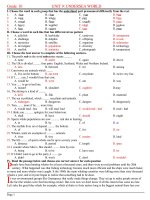Unit 9. Undersea world
Bạn đang xem bản rút gọn của tài liệu. Xem và tải ngay bản đầy đủ của tài liệu tại đây (2.2 MB, 20 trang )
Warm-up: What is this?
Starfish
Where
do these
TheySeal
live
in five
animals
live?
oceans.
Shark
Jellyfish
Turttle
whale
Look at the map and give Vietnamese
names for the oceans on the map.
TUESDAY , NOVEMBER 26th 2013
Period 58 : READING
I. Before you read:
Vocabulary:
- Mystery
(n): Điều bí ẩn
Vịnh
- gulf (n)
- marine (a) Thuộc về biển, ở biển
- Submarine (n): Tàu ngầm
- sample (n) Mẫu, mẫu vật
- Investigate (v) Điều tra, khám phá
- biodiversity (n) Sự đa dạng, phong phú
- Water current (n) Dòng hải lưu
- Organism (n) : Sinh vật
- tiny (a)
= very small
- Be at stake : = be at risk Đang bị đe dọa
UNIT
9:
I. Before
you read:
Task 1: Fill in each blank with one of the words in the box.
gulf
biodiversity
investigate
tiny
samples
Lesson 5: Language focus
1. Some plants and animals are referred to as
………...organisms because they are extremely small
2. Thank to modern technology, scientists have been
able to ………… the life of plants and animals that live
under the sea.
3. A………is a large area of the sea that is partly
surrounded by land
4. ……………….is a term that refers to the existence of
different kinds of animals and plants which make a
balanced environment
5. These scientists have collected different ……………to
II. While you read:
Read the text and do the task that follow.
Task 2. Answer the questions
1. What percentage of the earth’s surface is
covered by seas and oceans?
2. How do scientists now overcome the
challenges of the depth?
3. What can submarines do to help scientists
know about the undersea world?
4. What can we learn from the satellite photos?
5. What are the three groups of marine plants
and animals?
6. What would happen if the sea biodiversity
were not maintained?
II. While you read:
Task 2. Answers to the questions
1. 75% of the earth’s surface is covered by the seas
and oceans.
2. By using modern devices.
3. They help them to investigate the sea bed and bring
samples of the marine life back to the surface for
further study.
4. We can know a wide range of information including
water temperature, depth and the undersea
population.
5. Some of them live on or depend on the bottom,
some are swimming animals and others are tiny
organisms
6. The marine of life would be at stake.
III. After you read: Some pictures to help you know
more about the undersea world.
- Learn by heart the new words.
- Prepare for the Speaking lesson.
You are very lucky !
You are very lucky !
Question 1: What percentage of the
earth’s surface is covered by seas
and oceans?
=> 75% of the earth’s surface is
covered by the seas and oceans
Question 2: How do scientists now
overcome the challenges of the
depth?
=> By using modern devices
Question 3: What can submarines do
to help scientists know about the
undersea world?
=> They help them to investigate the
sea bed and bring samples of the
marine life back to the surface for
further study.
Question 4: What can we learn from
the satellite photos?
=> We can know a wide range of
information
including
water
temperature, depth and the undersea
population.
Question 5: What are the three
groups of marine plants and
animals?
=> Some of them live on or depend on
the bottom (like the starfish.)
Some are swimming animals (fishes,
sharks that move independently of
water current)
And others are tiny organisms
Question 6: What would happen if the
sea biodiversity were not
maintained?
=> The marine of life would be at stake
(if the sea biodiversity were not
maintained).









